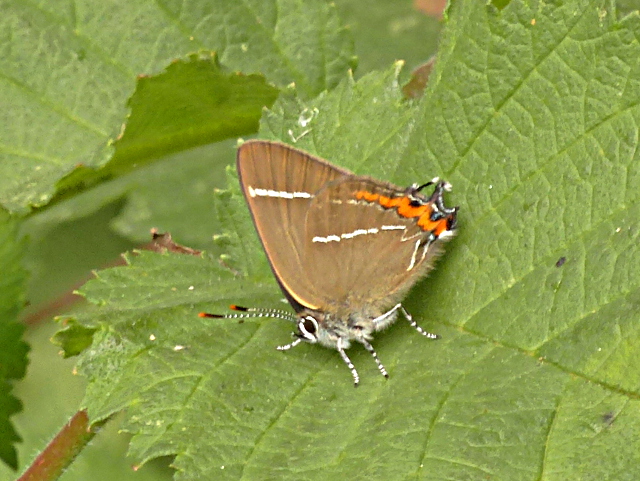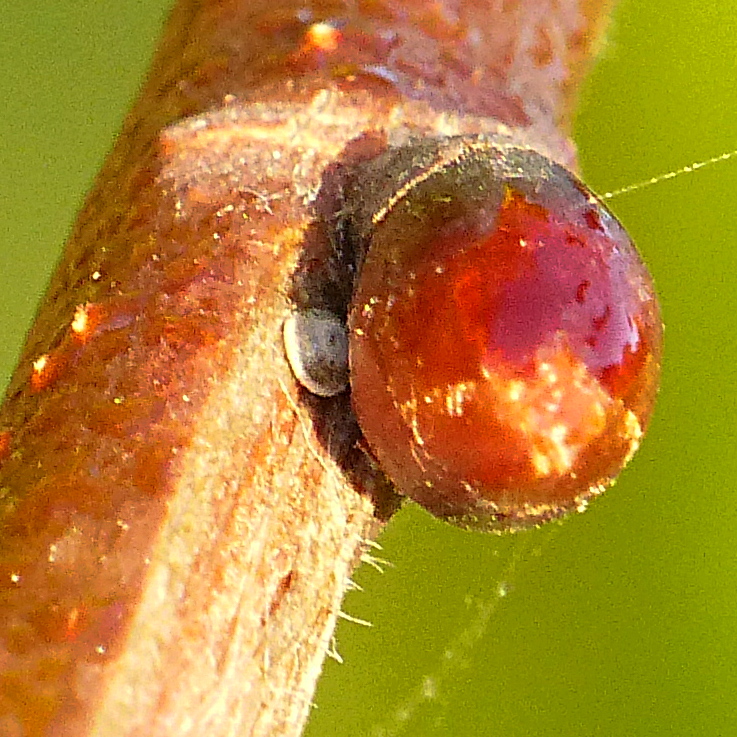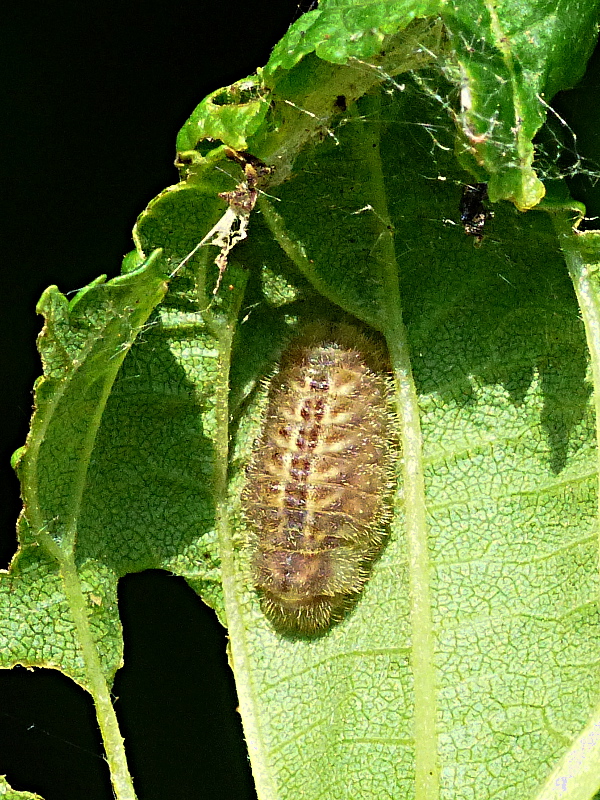Brown Argus
Brown Hairstreak
Chalkhill Blue
Clouded Yellow
Comma
Common Blue
Dark Green Fritillary
Dingy Skipper
Essex Skipper
Gatekeeper
Green Hairstreak
Green-veined White
Grizzled Skipper
Holly Blue
Large Skipper
Large White
Marbled White
Meadow Brown
Orange-tip
Painted Lady
Peacock
Purple Emperor
Purple Hairstreak
Red Admiral
Ringlet
Silver-washed Fritillary
Small Blue
Small Copper
Small Heath
Small Skipper
Small Tortoiseshell
Small White
Speckled Wood
Wall
White Admiral
White-letter Hairstreak
Extinct/rare immigrants
White-letter Hairstreak
Satyrium w-album
General Distribution and Status
This species is widespread and locally common on elm trees in most of England, apart from the far north-west, and in Wales. In 2017, it was found in Scotland for the first time since 1884 and eggs were found in Berwickshire on 4 February 2018. It was perhaps commonest in the Midlands until the 1970s (Heath et al.) but during that decade Dutch Elm Disease had a devastating effect on elm which is the butterfly's larval foodplant. There were concerns that the White-letter Hairstreak would become extinct but the insect can breed on regenerating young suckers at least until they reach a certain height. Disease-resistant elms are now being planted to ensure populations are maintained because colonies are still being lost at an alarming rate; it occurs in only about half the tetrads than were recorded in 1976 (Fox et al., 2015). Because of its elusive behaviour by mostly sitting around on the tree canopy, it is under-recorded so it is likely that more colonies are yet to be discovered. The status of the White-letter Hairstreak in Hertfordshire and Middlesex is similar but mainly due to the research and efforts by Andrew Middleton and Liz Goodyear many new colonies were found in the region which is encouraging. However, since 2011, both range and abundance have declined (Wood, 2016). Some new colonies have been discovered in the recent past but it is difficult to discern any real trend in abundance..
| United Kingdom | Herts & Middx | |||
| Distribution | 1976-2019 | -5% | 1980-2015 | +79% |
| Average 10-year trend | -2% | 2006-2015 | -43% | |
| 2024 since 2015-19 | -57% | |||
| Abundance | 1976-2024 | -80% | 1980-2015 | +25% |
| 2015-2024 | -13% | 2006-2015 | -81% | |
| 2023-2024 | -42% | 2024 since 2015-19 | 0% | |
UK distribution map
UKBMS Species summary
Habitat Requirements
The White-letter Hairstreak can be found on hedgerows, edges of woodland and isolated clusters of elms even in urban areas. The same breeding sites tend to be used every year.
Larval Foodplants
Wych Elm Ulmus glabra, English Elm Ulmus procera, Small-leaved Elm Ulmus minor. One disease-resistant form of elm is Dutch Elm also known as 'Sapporo Autumn Gold' Ulmus japonica.
Adult Food Sources
Bramble Rubus fruticosus agg. (236), Creeping Thistle Cirsium arvense (24), Honeydew (15), Wild Privet Ligustrum vulgare (12).
Historical Records
According to Gibbs Durrant found the butterfly in Knebworth, probably in the woods complex in the 19th century. There are several reports in the 20th century scattered from all round the county except the agricultural north-east. Foster in his 1945 report describes it as 'numerous' in the county and Roger Ferry found colonies in Knebworth Woods in 1948 and 1950. In 1943-44, Rev Greenham noted it in Box Wood and in the same decade it was seen in High Wood, near Benington (Birdsall). John Tomkins saw the butterfly in Watery Grove in 1973 and 1977 and at the Astonbury Wood Nature Reserve in 1976 but notes that it was probably extinct at the latter by 1978 through Dutch Elm Disease (Tomkins & Burton 1976, 1978). There is a record of a sighting at Monks Wood in 1977 (Waterton).
Local Distribution and Abundance
Colonies of the White-letter Hairstreak appear to be scattered throughout the Stevenage area but as mentioned previously it is possible that there are other populations present. Great Ashby Park and Six Hills Common are the best sites to find the species currently although the north-western part of Knebworth Park also held good colonies. Four individuals were found feeding on thistles, etc. at Norton Green Common on 12 July 2018. About 20 specimens were seen flitting half way up one elm at around 7:45 am on 19 June 2017 at Six Hills Common. At least ten individuals were reported from Great Ashby Park feeding on thistle on 7 July 2007 between 5:45 and 6:45 pm by Steve Lane. The two records for tetrad TL22I refer to eggs found during the winter; south Graveley on 31 January 2007 and near St Nicholas Church on 24 February 2010. There was also an egg found near Walkern Church on 14 February 2018. 2019 appeared to have been a relatively poor year at Six Hills Common with a maximum number of five, seen on 29 June. Unfortunately, the decline continued in 2020 with only two or three seen at the most at Six Hills Common (on 21 June) although seven were counted in the Knebworth Woods complex during the Wider Countrywide Survey on 17 July which is encouraging. Only five reports were submitted in 2021, all at Six Hills Common, which is very concerning, There was good news from earlier in the year when an egg was found on the A602 roadside at Bragbury End. 2022 was even worse with only two reports, both at Six Hills Common, consisting of probably four individuals. Perhaps due to the fine weather in June, more sightings were reported at Six Hills Common in 2023 with at least five seen on 23 June. Six Hills Common was the only site with reports of this butterfly in 2024 including five specimens on 22 June. Of the transects, only Knebworth Park has reports of any specimens.

Knebworth Park transect 1996-2010 and 2017-2025
The highest count of 12 was found here on 20 July 2006 by Ken King who says that 'numbers continue to rise in two clear areas both with elm trees having a trunk diameter of about 6cm' in 2005 (Murray & Wood). A number were seen in the muddy area at ground level (TL225213) near the entrance to Wintergreen Wood. There have been no sightings since the resumption of the transect in 2017. Due to the butterfly's tree-topping behaviour no trend in abundance can be determined.

Life History
Earliest date: 14 June 2017 at Six Hills Common
Latest date: 7 September 2015 at Great Ashby Park
This species produces
only one generation a year with most adults emerging in July. The chart is slightly misleading because 23 specimens were counted between 3 and 7 July 2007
at Great Ashby Park thus precluding a more even spread of flight times for the butterfly. The 14 June sighting at Six Hills Common in 2017 is the earliest
on record undoubtedly because of the warm and dry weather speeding up larval development in the spring. The specimen seen on 7 September 2015 is unusually late. Females
lay eggs singly, usually on a scar between old and new growth and spends the winter in this stage. In the spring, larvae emerge to feed firstly on the buds
then on the leaves. In June, a pupa is formed attached to a twig or stem.
Behaviour/Observation notes
Like most of the other hairstreaks this species is not easy to find as it spends much of its time flitting over the tops of elm trees. Probably the best time of day to find it is in the early morning, say 09:00 hours, for males which actively defend their territories in the canopy. Any brown 'speck' jinxing about may well be a White-letter Hairstreak. Both sexes do occasionally descend to lower levels to feed on nectar but their wings are always closed when resting or feeding. The butterfly overwinters as an egg and searching for the eggs is a good way to find colonies. Finding flowery elms in the winter and early spring should be easy to locate with their pink or white blossoms.
Variations/Aberrations
Variations are very rare for this butterfly and none have been reported in Hertfordshire.
Find out more on the UK Butterflies website
References

Six Hills Common 25 Jun 2015 (f)

Egg Six Hills Common 21 Oct 2018

Larva Six Hills Common 13 May 2018

Larva Six Hills Common 27 May 2018





